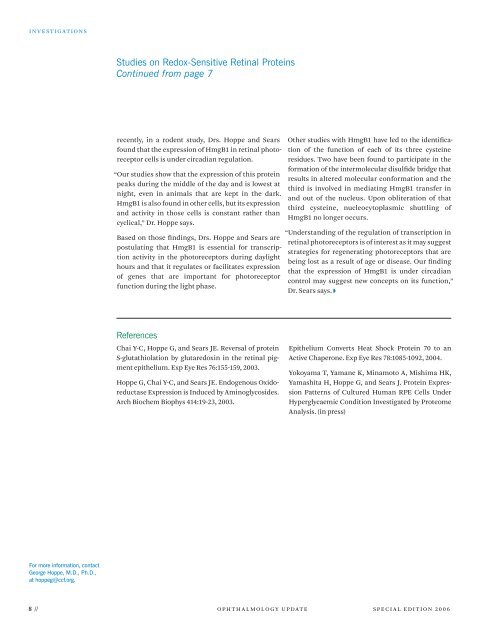Ophthalmology Update - Cleveland Clinic
Ophthalmology Update - Cleveland Clinic
Ophthalmology Update - Cleveland Clinic
Create successful ePaper yourself
Turn your PDF publications into a flip-book with our unique Google optimized e-Paper software.
i n v e s t i g a t i O n s<br />
For more information, contact<br />
George Hoppe, M.D., Ph.D.,<br />
at hoppeg@ccf.org.<br />
Studies on Redox-Sensitive Retinal Proteins<br />
Continued from page 7<br />
recently, in a rodent study, drs. hoppe and sears<br />
found that the expression of hmgB1 in retinal photoreceptor<br />
cells is under circadian regulation.<br />
“Our studies show that the expression of this protein<br />
peaks during the middle of the day and is lowest at<br />
night, even in animals that are kept in the dark.<br />
hmgB1 is also found in other cells, but its expression<br />
and activity in those cells is constant rather than<br />
cyclical,” dr. hoppe says.<br />
Based on those findings, drs. hoppe and sears are<br />
postulating that hmgB1 is essential for transcription<br />
activity in the photoreceptors during daylight<br />
hours and that it regulates or facilitates expression<br />
of genes that are important for photoreceptor<br />
function during the light phase.<br />
References<br />
chai y-c, hoppe g, and sears Je. reversal of protein<br />
s-glutathiolation by glutaredoxin in the retinal pigment<br />
epithelium. exp eye res 76:155-159, 2003.<br />
hoppe g, chai y-c, and sears Je. endogenous Oxidoreductase<br />
expression is induced by aminoglycosides.<br />
arch Biochem Biophys 414:19-23, 2003.<br />
Other studies with hmgB1 have led to the identification<br />
of the function of each of its three cysteine<br />
residues. two have been found to participate in the<br />
formation of the intermolecular disulfide bridge that<br />
results in altered molecular conformation and the<br />
third is involved in mediating hmgB1 transfer in<br />
and out of the nucleus. Upon obliteration of that<br />
third cysteine, nucleocytoplasmic shuttling of<br />
hmgB1 no longer occurs.<br />
“Understanding of the regulation of transcription in<br />
retinal photoreceptors is of interest as it may suggest<br />
strategies for regenerating photoreceptors that are<br />
being lost as a result of age or disease. Our finding<br />
that the expression of hmgB1 is under circadian<br />
control may suggest new concepts on its function,”<br />
dr. sears says.<br />
epithelium converts heat shock protein 70 to an<br />
active chaperone. exp eye res 78:1085-1092, 2004.<br />
yokoyama t, yamane K, minamoto a, mishima hK,<br />
yamashita h, hoppe g, and sears J. protein expression<br />
patterns of cultured human rpe cells Under<br />
hyperglycaemic condition investigated by proteome<br />
analysis. (in press)<br />
// O p h t h a l m O l O g y U p d a t e s p e c i a l e d i t i O n 2 0 0 6
















